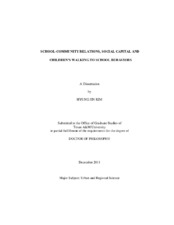| dc.contributor.advisor | Lee, Chanam | |
| dc.creator | Kim, Hyung Jin | |
| dc.date.accessioned | 2012-02-14T22:19:52Z | |
| dc.date.accessioned | 2012-02-16T16:17:38Z | |
| dc.date.available | 2014-01-15T07:05:30Z | |
| dc.date.created | 2011-12 | |
| dc.date.issued | 2012-02-14 | |
| dc.date.submitted | December 2011 | |
| dc.identifier.uri | https://hdl.handle.net/1969.1/ETD-TAMU-2011-12-10402 | |
| dc.description.abstract | In spite of increasing interests in the relationship between neighborhood environments and children's walking-to-school behaviors, few studies have examined the dynamic nature of school-community relationships from physical and social perspectives. Questions such as how centrally the school is located within the larger community, and how connected or accessible the school is to the surrounding communities, will have significant implications for children?s walking to school and physical activity behaviors and also for the community's social capital.
The primary aims of this study are: (a) to assess the association between school-community relations and social capital among parents of school children; (b) to assess the relationship between school-community relations and walking-to-school behaviors among school children; and (c) to examine the mediating effects of social capital on the relationship of (b).
This cross-sectional study focuses on children and parents from 19 elementary schools in the Austin Independent School District (AISD) in Austin, Texas, utilizing the parental Safe Routes to School (SRTS) survey and conducting a follow-up Parental Social Capital survey to gather additional in-depth data on social capital. Also objective measurements are performed to assess school-community relations and physical environments using the spatial centrality index and Geographical Information System (GIS) network analysis at/around schools and surrounding communities. Data analyses are conducted based at the school/community-level and the individual-level (large full data and small sub-group data) separately by using ANOVAs, bivariate statistical analysis and multivariate statistical models.
Overall findings of this study show that: (a) neighborhood schools have more students walking to school and a higher centrality of the school than non-neighborhood schools; (b) differences in social capital between neighborhood schools and non-neighborhood schools are not significant or are only marginally significantly; (c) two social capital variables, "volunteerism" and "social cohesion" are correlated with children's walking-to-school behaviors but no significant mediating effect is found for social capital in the association between school-community relations and children's walking-to-school behaviors; and (d) "volunteerism" is shown to be positively correlated with "perceived centrality" but negatively associated with all objective centrality measures. The other social capital variable of "social cohesion" has a positive correlation with one of the objective centrality measures, "closeness centrality."
Findings of this study may contribute to research exploring the dynamics of school-community relations with socio-spatial perspectives, and also bring attention to the policy makers for school siting in the large community context and evidence-based knowledge promoting healthy community design. | en |
| dc.format.mimetype | application/pdf | |
| dc.language.iso | en_US | |
| dc.subject | school-community relation | en |
| dc.subject | neighborhood school | en |
| dc.subject | community design | en |
| dc.subject | social capital | en |
| dc.subject | physical activity | en |
| dc.subject | school transportation | en |
| dc.subject | walking to school | en |
| dc.title | School-Community Relations, Social Capital and Children's Walking to School Behaviors | en |
| dc.type | Thesis | en |
| thesis.degree.department | Landscape Architecture and Urban Planning | en |
| thesis.degree.discipline | Urban and Regional Science | en |
| thesis.degree.grantor | Texas A&M University | en |
| thesis.degree.name | Doctor of Philosophy | en |
| thesis.degree.level | Doctoral | en |
| dc.contributor.committeeMember | Varni, James W. | |
| dc.contributor.committeeMember | Neuman, Michael C. | |
| dc.contributor.committeeMember | Kwok, Oiman | |
| dc.type.genre | thesis | en |
| dc.type.material | text | en |
| local.embargo.terms | 2014-01-15 | |


